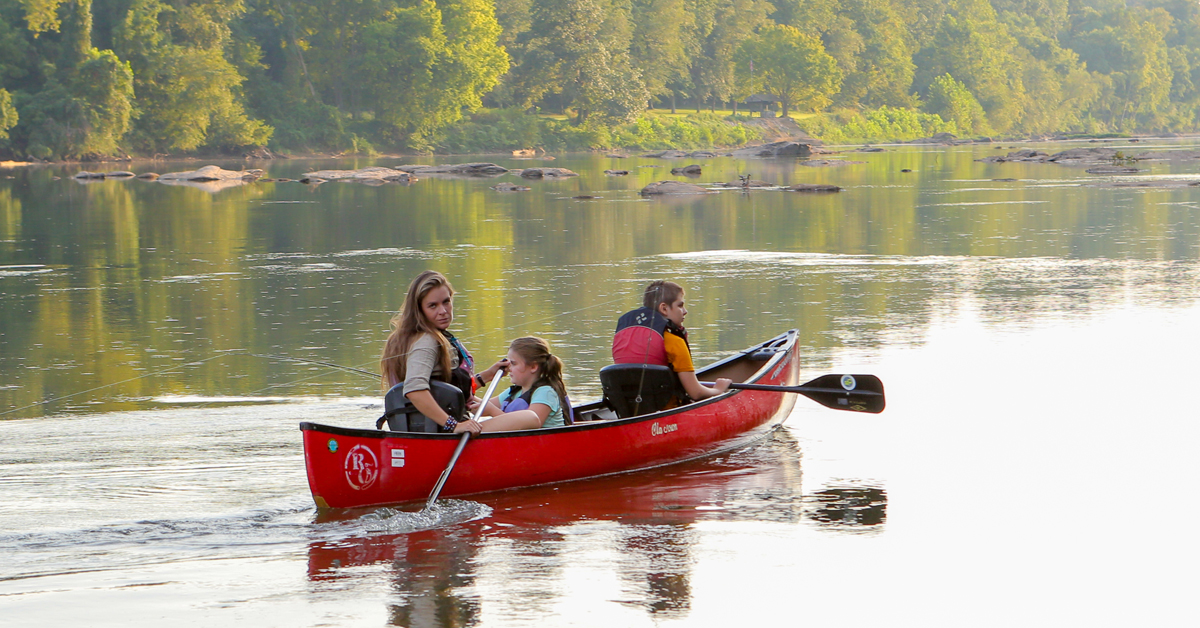
By John Page Williams
Photos by Meghan Marchetti/DWR
Like pickup trucks, open canoes have many uses, whether for families or for folks who must carry a lot of gear. Remember, they evolved as working boats. From the wild rice marshes of Virginia’s many tidal fresh creeks to our salt marsh lagoons, they’re great vessels for exploring the wild. There are tricks, though, that make those adventures easier and more fun.
If you’re new to paddling, first learn the basic strokes: Bow, reverse, J-stroke, sweep, pry, draw, and cross-draw. They’re all about efficient use of muscles.
Tandem paddling (with a partner): It’s satisfying to paddle well with a partner. Anyone who has read The Boys in the Boat will remember the quest to get all eight oarsmen in their Olympic rowing shell into “The Swing.” That’s a state in which everyone is synchronized, and they can feel the boat accelerate. The Swing comes easily in a canoe when two paddlers synchronize. The bow person sets a steady rate, and the person in the stern follows it, while also constantly correcting the boat’s course as necessary with a J-stroke. Learning The Swing is well worth the time invested. It’s a great feeling, and it helps the canoe cover miles with minimal effort.
Maneuvers: Canoes are great vessels for exploring winding tidal creeks. Here the strokes that move part of the canoe sideways come into play. When tandem paddlers learn to use combinations of the sweep, pry, draw, and cross-draw, they’ll have great fun pivoting in smooth, quick, sharp turns going up winding channels.
Stern vs. Bow: When two paddlers are of different sizes, or strengths, the standard configuration is for the stronger to paddle stern, using a J-stroke to keep the boat on course. If the crew change position, the stronger bow stroke will tend to turn the boat away from the side that person is paddling on, and the stern J-stroke will reinforce, not correct that turn. The solution is simple, having the stern person counteract that turning force with a K-stroke. Here, he/she begins each stroke by first reaching forward and to the side, essentially beginning each stroke with a little bit of a draw.
Adjusting to Wind or Current: On flatwater, wind is a constant. Unless you’re paddling directly into or with it, it will tend to push the windward end of the canoe sideways. There are ways to use that force to advantage. For example, if the wind is on the port (left) bow, having the stern paddler paddle on the starboard (right) side will counteract it, reducing the effort of J-strokes. In time, you’ll develop a feel for working with, instead of against, this wind effect, and you’ll find your stern strokes become hybrids of the standard configurations, depending on what adjustment the canoe needs to stay on course. An experienced canoeing instructor once remarked that “You’ll always put ‘a little bit of fish’ into the beginning or end of every stroke.”
Paddling solo with a double-blade: One last trick. If a canoe is like a pickup truck and you’re paddling solo, using a double-bladed paddle is like dropping a diesel under the hood. Try it on land first. Pick up a long double-blade (figure on 260-280 cm. in length) and take a stroke as you would by rotating your upper body as you push forward with your upper hand while using your lower hand as a fulcrum. Repeat on the other side. It’s a natural movement. Now place a pad just forward of stern thwart of your boat, launch, board, and kneel on the pad, resting your tail on the thwart. Just start paddling. It’s natural, a great way to travel on the water. Not only will you be able to keep up with tandem crews, but you’ll have more control in headwinds with a single paddle. By the way, double-blades haven’t always been unusual choices for canoes. They were popular, for example, around the turn of the 20th century along big waterways like the St. Lawrence River.
Odds are that your paddle has two parts and that when you put it together, you’ll be able to offset the two blades by 60-90 degrees to “feather” the upper blade in each stroke, thereby reducing wind resistance. Now grasp the paddle with your dominant hand at a right angle to the blade on that side. Allow the paddle shaft to rotate in your other hand. Now (still on land), take a stroke on the dominant side and, as you recover, raise that wrist as you prepare to stroke on the other side. Almost like magic, you’ll find the other blade to be in perfect position for the offside stroke. Take it and as you do, return your dominant wrist to the former position for the next dominant-side stroke.
Resources for Learning Basic Canoe Paddling
The American Canoe Association has lots of information and videos on paddling basics and techniques.
Paddling.com has articles and videos on strokes, safety, gear, and more as well as a search feature for instructors.
John Page Williams is a noted writer, angler, educator, naturalist, and conservationist. In more than 40 years at the Chesapeake Bay Foundation, Virginia native John Page championed the Bay’s causes and educated countless people about its history and biology.


